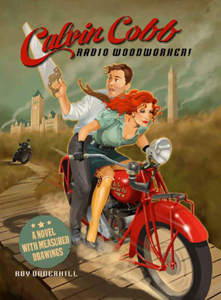
BOOK REVIEW:
Calvin Cobb: Radio Woodworker, by Roy Underhill
by J. Norman Reid
Delaplane, VA
Roy Underhill is many things—woodworker extraordinaire, teacher, author of
woodworking and public speaking books; many have called him a saint. But Roy is now
even something more—a novelist. And what an entry into the world of fiction! Imagine
yourself in the midst of pre-World War II Washington, D.C., then a sleepy cowtown, not
yet the pressure-packed, high-paced fishbowl it has become. Ho hum. Can't be much
going on there. Seems like a sure recipe for boredom, doesn't it?
But
Calvin Cobb: Radio Woodworker
is no dreary recitation of the daily grind of public
servants at their bureaucratic routines. Racing—and I do mean racing—through its
pages is a dynamic and wholly unexpected tale of mirth and mystery that is frankly hard
to put down. A quick read, Calvin Cobb takes you on a wild ride through 1937
Washington's social and political scene.
The setting itself—reflecting Roy's famous wit—is preposterous on its face. Calvin
Cobb, naïve and reserved, is chief of the Broadcast Research Section of the
Department of Agriculture. You think you know what that means, don't you? Well,
you're probably wrong, and you'll have to read the book to understand why Calvin and
his all-girl team put a supercharged tractor to work, only to end up with you-know-what
on their faces.
Calvin's team is precariously housed in the tower of the Old Post Office Building on
Pennsylvania Avenue, just blocks from the White House. In their high perch they
employ punch card tabulators to process the results of their research, all the while
developing their capacity of their machinery and advancing computer science to new
levels that provoke the envy of others.
A chance encounter with a fascinating woman leads the reserved Calvin, who's
studying Dale Carnegie on how to improve his social skills, to try his hand at
broadcasting—as a radio woodworker, of all things. Despite Calvin's doubts about his
program's value, his audience grows rapidly and requests for plans for each show's
project start rolling in. Calvin's whiz team adapts their computer to keep pace with the inquiries as the show's popularity blossoms and the mailbags requesting plans grow to
burgeoning but unexplained numbers.
Thrown into the mix are an unpleasant encounter with the FBI over the matter of a
misplaced digit and a charge that Calvin has bilked the government of millions of
taxpayer dollars. A wild ride to escape the police on the back of a vintage Indian Scout.
A trolley ride to fashionable Glen Echo Park, all the while smelling of pig dung. A
frightening encounter with government auditors who threaten to shut down his section,
all because—can you believe it?—Calvin's pet rat ate his audit report. Midnight
encounters with a gifted woodworker who moonlights uninvited in Calvin's workshop
and whose Stanley no. 45 combination plane Calvin admires.
Fun, fast-moving and filled with vivid though sometimes arcane period details about
farm machinery, computing and radio equipment, government agencies and cat faces
staring out from marble walls, Roy creates unique and engaging characters whose fate
propels the reader's interest from one chapter to the next. Yet despite the heavy
overlay of humor that pervades the story line and many of its details, the novel also
bears a valuable social message as Calvin confronts the racism and anti-Semitism of
the day.
The ending, which I won't reveal here, is both dramatic and—like the rest of the
book—absurdly humorous. A wild ride indeed!
I have but a single criticism. A former Department of Agriculture employee like Calvin, I
only wish Roy had waxed eloquent over the marvelous white oak doors and transoms
that line the many halls of the South Agriculture Building, once the largest office building
in the world. It is a point of humor among USDA employees that the regular, almost
cell-like arrangement of offices along the red tile-paved halls reflects the design
proclivities of its architect, who also built Leavenworth Prison. But even lacking these
architectural features, Calvin Cobb is so richly detailed that it readily transports the
reader into the midst of that earlier time and place.
To conclude, I will pose two questions. Will you enjoy this book? The answer to that is
a resounding "yes"! While the book makes recurring references to woodworking
techniques and tools, this is by no means a woodworking book. It is, instead, a farce
with lots of human interest and flights of fancy. As a result, both woodworkers and
those with no interest whatsoever in our favorite avocation will find this book a pleasant
diversion, no, a total hoot! In other words, you can give a copy to your spouse or
partner, expecting them to revel in it and you can then read it when they are finished.
But the even bigger question is this—now that Roy Underhill has gotten a first novel
under his belt, what does he plan to do for an encore? Just as was true for Calvin
Cobb, his eager public awaits his answer.
CLICK HERE to order your copy of
Calvin Cobb: Radio Woodworker
The reviewer is a woodworker, writer, and woodworking instructor living with his wife in the foothills of the Blue Ridge Mountains with a woodshop full of power and hand tools and four cats who believe they are cabinetmaker's assistants.
He can be reached by email at
nreid@fcc.net
.
Return to
Wood News
front page


